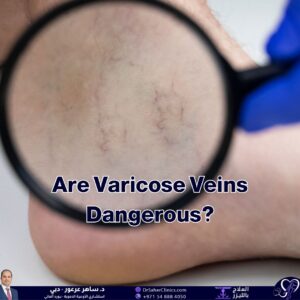Many people suffer from Varicose Veinss, a condition characterized by enlarged and swollen veins under the skin. These veins can be visible to the naked eye and cause pain and discomfort. However, the question remains: Is Varicose Veins disease dangerous? In this article, we will explore this question in detail, focusing on the causes, symptoms, and treatment options.

What Are the Causes of Varicose Veins Disease?
To understand whether Varicose Veins disease is dangerous, it is important to know the causes behind Varicose Veinss. The condition usually occurs due to weakened venous valves, allowing blood to pool in the veins instead of returning to the heart. Several factors can contribute to the development of Varicose Veinss, including:
- Genetics: Individuals with a family history of Varicose Veinss are more likely to develop them.
- Pregnancy: Increased blood volume during pregnancy puts additional pressure on the veins.
- Obesity: Excess weight adds pressure to the veins, increasing the risk of Varicose Veinss.
- Prolonged Standing or Sitting: Remaining in a static position for extended periods can increase vein pressure.
What Are the Symptoms of Varicose Veins Disease?
Symptoms vary depending on the severity of the condition, but common symptoms of Varicose Veinss include:
- Leg Pain: A person may feel heaviness or aching in the legs, especially after prolonged standing.
- Swollen and Bulging Veins: The veins appear swollen and prominent under the skin.
- Itching and Cramps: Itching in the affected area may occur, and sometimes nighttime muscle cramps develop.
When Should You Be Concerned About Varicose Veins Disease?
In general, Varicose Veins disease is not considered dangerous in most cases. However, Varicose Veinss can sometimes lead to complications that require immediate medical attention. These complications include:
- Venous Ulcers: Occur when Varicose Veinss cause skin damage and ulcer formation.
- Blood Clots: Varicose Veinss can increase the risk of blood clots forming in deep veins.
- Bleeding: Swollen veins can burst in some cases, causing bleeding.
- Therefore, anyone experiencing severe symptoms or complications should consult a doctor.
What Are the Treatment Options?
Several treatment options are available for Varicose Veinss, depending on the severity of the condition and the patient’s needs. These options include:
Compression Stockings: Improve circulation and reduce swelling.
Sclerotherapy: A solution is injected into the affected veins, causing them to shrink and disappear.
Laser Treatment: Laser is used to close damaged veins and prevent blood flow.
Catheter Procedure: A thin, flexible tube used to treat large veins.
Surgery: In severe cases, surgical removal of damaged veins may be necessary.
Varicose Veins Treatment at Dr. Saher Arour’s Clinics
Dr. Saher Arour’s clinics provide exceptional services in treating Varicose Veinss using the latest medical technologies. Dr. Saher Arour’s extensive experience in this field allows him to offer patients a comprehensive treatment plan that includes precise diagnosis and effective treatment. The clinics use modern equipment and innovative treatment methods to ensure the best results and reduce complications. For more information about the services at Dr. Saher Arour‘s clinics, you can visit the clinics’ YouTube channel.
Conclusion
In conclusion, the answer to the question Is Varicose Veins disease dangerous? depends on the severity of the condition and the symptoms experienced by the individual. In most cases, Varicose Veinss are not considered dangerous and can be effectively managed through self-care and appropriate medical treatment. It is essential to consult a doctor for accurate diagnosis and treatment to avoid potential complications. If you seek specialized medical care for Varicose Veinss, Dr. Saher Arour’s clinics offer the best solutions to ensure your health and safety.
